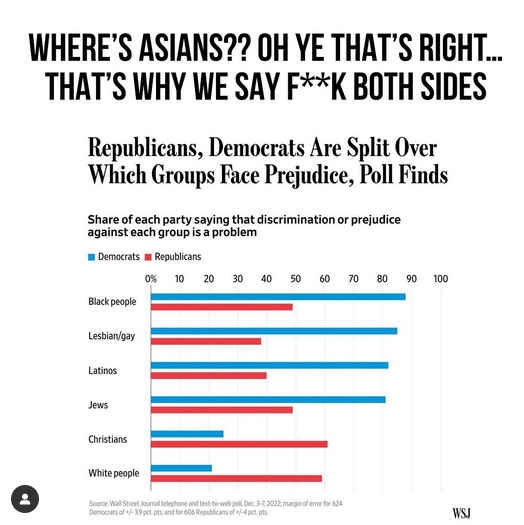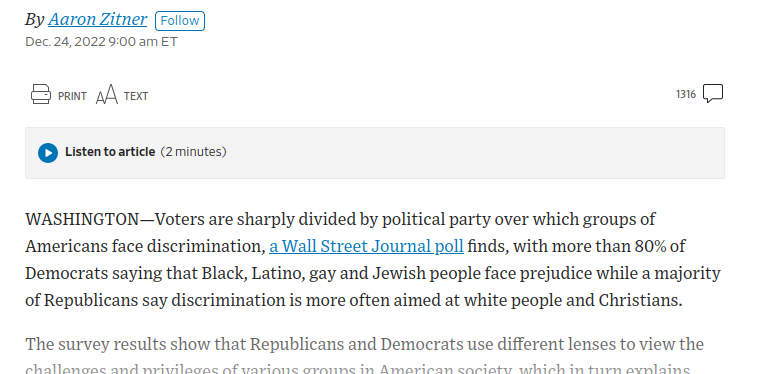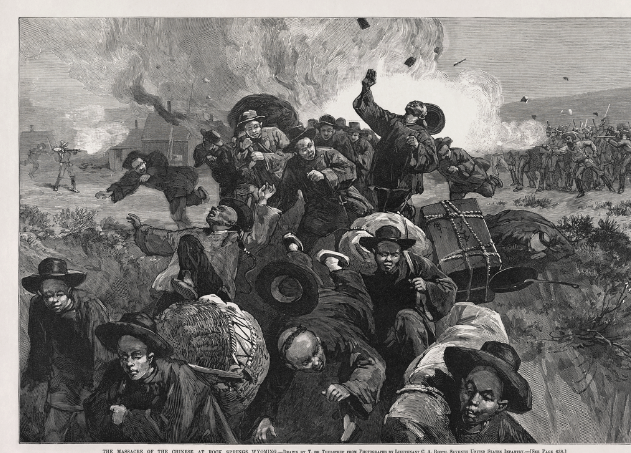Every once in a while, I get upset by something AWA puts up, especially anything that discourages Asian American participation in politics. This time, it was a poll about how the two parties differ in who they think suffers discrimination.

Asian American’s aren’t in there.
They make it look like Republican and Democrat voters don’t care about anti-Asian prejudice.
The poll excluded Asians, by not asking if Asians suffered prejudice.
Right now, we are experiencing big increases in anti-Asian violence. They should be asking about us.
The pollsters are being racist.
This fits the agenda of the Model Minority Myth, that Asian Americans don’t suffer anything at all.
Polls like this perpetuate the lie that Asian Americans have no problems.
That discourages participation in politics.
Here’s How I Figured This Out
Whenever you see a news story about a survey, it’s a good idea to at least glance at the survey.
First, go to the article. There’s a link to the poll.

When you click on the link you get a report that looks like this:

Here’s a link to the report: https://s.wsj.net/public/resources/documents/Full-Results-WSJPoll-Dec-2022[15][3].pdf
The companies that were paid by WSJ to do this poll were Impact Research and Fabrizio Lee.
Impact Research does polling for the Democratic Party.
Fabrizio Lee does polling for the Republican Party.
So, among the party elite, they really do not care about Asian Americans.
That says nothing about the voters. The voters were denied a voice about us.
More About Surveying and Polling Asian Americans
Why Asian Americans often appear underrepresented in polling and research by Stacy Chen, ABC News
The challenges of polling Asian Americans by George Gao, Pew Research Center
The Pew article says that polls will drop results for groups that don’t get 100 responses, because they can’t be accurate with a small sample. Asians often don’t have 100 responses, and our data is dropped.
In the case of this WSJ poll, they knew they wouldn’t get enough Asian responses. Did they decide to exclude a question about anti-Asian discrimination based on that?
That seems to be a case of “if you aren’t numerous enough to matter, then what matters to you can’t matter.”
So, how you do address this problem of undercounting, and non-reporting Asian American responses?
“Oversampling”. Polling more Asian Americans.
From the Pew article:
How pollsters currently survey Asian Americans
from The challenges of polling Asian Americans by George Gao
In order to accurately portray Asian Americans’ views in surveys, pollsters first have to obtain a large and representative sample of Asian Americans. Then they need to translate the questionnaire into enough languages so respondents are able to share their opinions clearly.
Pollsters can do this by fielding a sample of all U.S. adults in which Asians are oversampled – which means they are polled at a disproportionately higher rate than normal; such an oversample makes it possible to compare views among Asians with other groups, such as blacks, Hispanics and whites, while also including Asians in the national U.S. sample through proper statistical weighting. Pollsters can also do this by designing a study in which only Asians are interviewed, as we did in our 2012 reports, “The Rise of Asian Americans,” and “Asian Americans: A Mosaic of Faiths.”
Self Surveying
Polling shapes politics, giving activists, politicians, and policymakers information to prioritize efforts. Excluding data about whether people think anti-Asian racism matters leaves everyone guessing. Consequently, small groups self-survey to find out opinions. Here are some surveys:
2022 Asian American Voter Survey by APIA Vote
2022 Vietnamese Voices Orange County by VietRise
2020 Asian American Voter Survey by AAPI Data
National Asian American Survey
These tend to show Asians leaning Democrat and favoring social programs. This reflects the demographic reality of Asian America: mostly living in or near cities, and more consider themselves people of color than white or other.







Leave a Reply